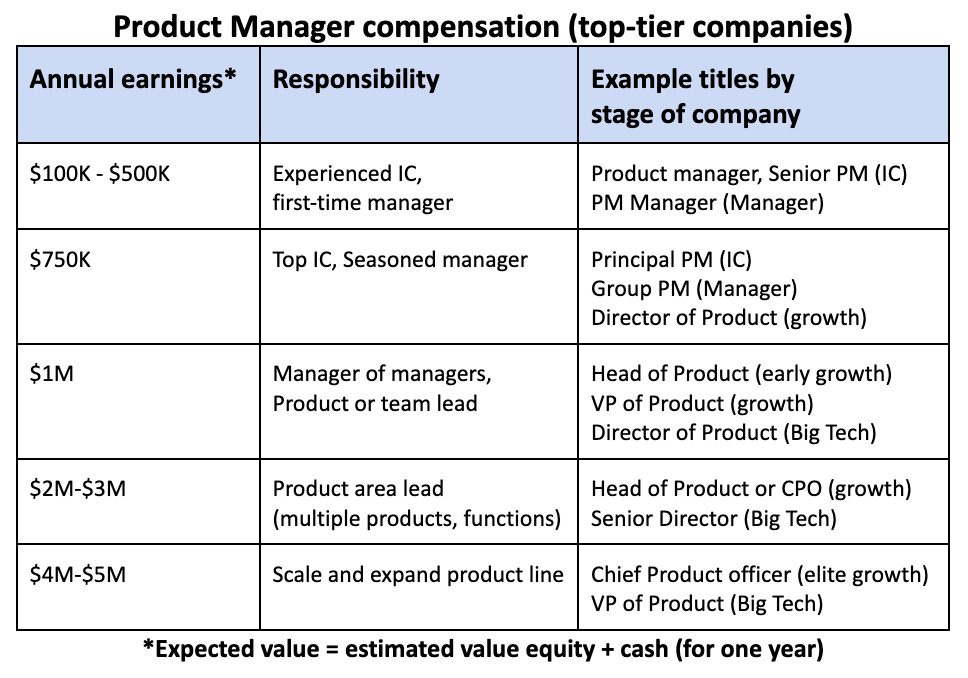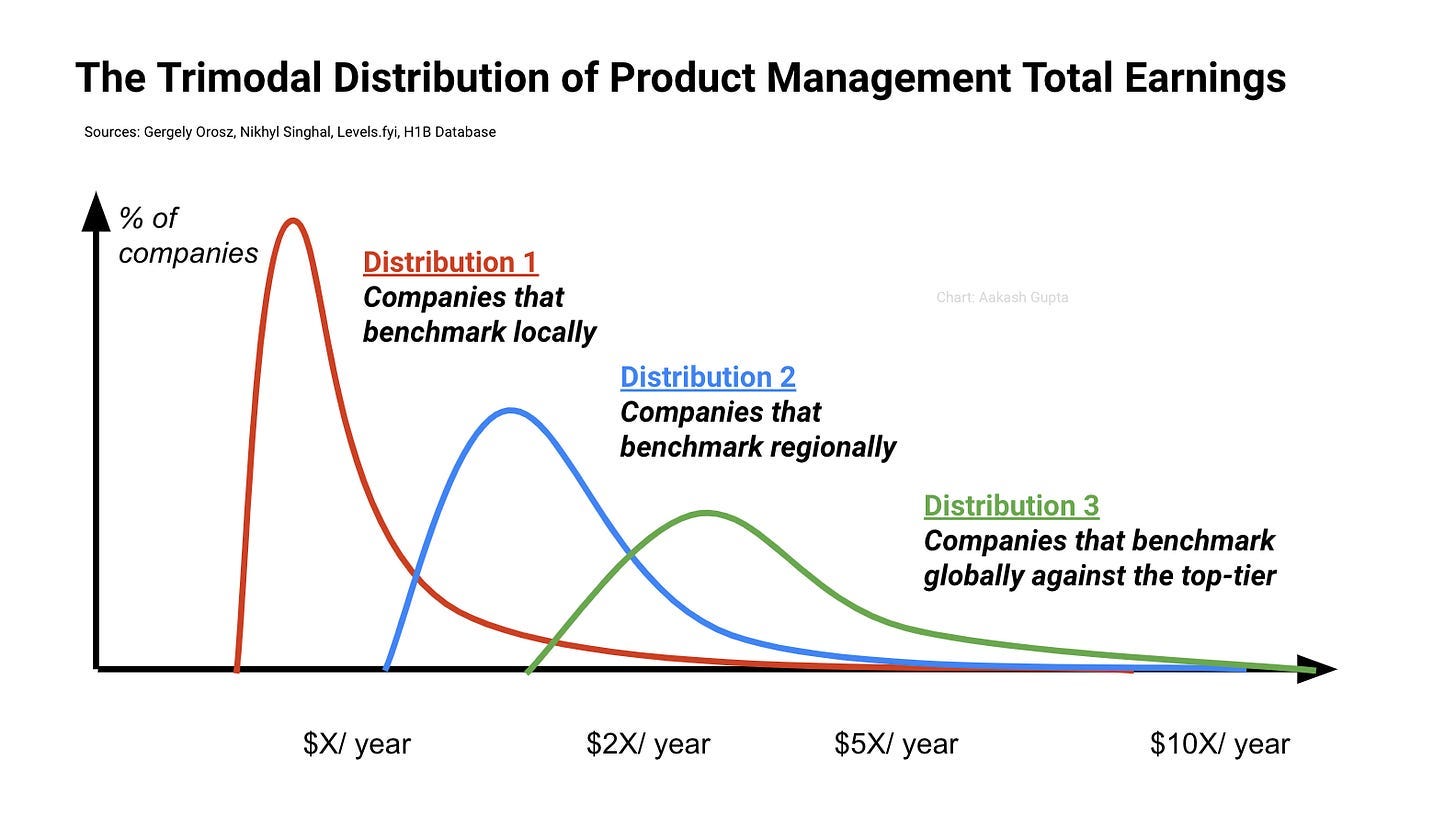Want to learn how to become a product manager without experience? This can be an excellent career path given how well product management pays.
At the “top tier” (like FAANG), total compensation is much higher than most realize.
Nikhyl Singhal, VP at Facebook, shared these mind-blowing stats:
The high end of companies pay 10x! In India or the Philippines, a PM at a startup will earn $10-$50K. That’s 1/10th of these top-tier firms, where they earn $100-$500K.
Even in the US, there are entry level PMs who earn $80K and are happy they work at a cool startup. But similarly tenured PMs at FAANG can earn as much as 6x that, $480K.
This is the trimodal distribution of salaries at work. Gergely’s initial observations for engineers can be adjusted to be even more dramatic for Product Manager’s:
Here’s the takeaway: Getting into a higher part of the distribution could change your life. And that’s the point of my new book:
The Ultimate Guide to Getting a PM Job.
The book is going to help you go one tier up, wherever you are.
Having transitioned from a small startup in Michigan to Google, I have firsthand experience climbing these tiers. On top of that, I’ve always been working with hundreds of fellow subscribers over the past few years to get them jobs.
For the book, I’m putting together everything I’ve learned into one package.
This will be releasing on ProductHunt next weekend. I will be sending an e-mail then asking for an upvote, and I would love your support!
Is it Possible to Get a Product Manager Job Without Experience?
First things first - can you really learn how to become a product manager without experience?
Especially in this market, it seems virtually impossible. But we’re here to show you it’s possible in this guide on how to become a product manager without experience.
This has been the number one thing you all have been reaching out to me about recently.
Well, I’m here to tell you: You can get a PM job without any experience, without an MBA, and without a CS degree.
I first put out this roadmap 1.5 years ago. Since then, I’ve worked with over 50 of you to successfully get PM jobs. Here’s what some have said:
“No one else is quite as clear with what you must do, as far as tactics and strategy.”
“By far the most realistic advice out there. Thank you!”
“Thank you, Aakash Bhai, for changing my life.”
“I just doubled my TC!!!!”
What I’ve worked on with these 52 folks is six specific things:
Self-assessment
Long-term plan
Executing the plan
LinkedIn & Resume redesign
How to find the right jobs
Interview advice
Over time, I’ve refined the systems and market-tested them to perfection.
In today’s piece, I’m finally ready to break down the exact systems I have used to get people PM jobs. Even if today’s piece doesn’t apply to you, this is the definitive piece you can forward people to when they ask you.
How to Become a Product Manager Without Experience: The Complete Guide
So, without further ado, let’s get into it.
1. Self-assessment
Your self-assessment should follow 3 steps: learn where you stand, identify an appropriate target job, and then work backwards.
Step 1 - Learn Where You Stand
Your first step should be to get a realistic understanding of where your gaps are to become a PM. Let’s give you a quick primer on how different backgrounds affect your chances to become a PM.
There are four major types of backgrounds that enable you to approach this process differently. I’ll refer to these as ‘archetypes’ throughout the rest of the piece. Let’s figure out which you are:
CS Degree
Product Adjacent Experience
Irrelevant Degree & Experience
Student
Archetype 1: CS Degree
If you have a computer science degree, you’re significantly ahead of the pack:
You can build apps to actually manage a product.
You can understand technical concepts, so you can work on technical products.
If you’re in this group and have work experience, you may be able to secure an offer at one level lower than you are now. So if you are a senior individual contributor (IC), you may be able to come in as a normal IC, versus having to be a junior IC.
Archetype 2: Product Adjacent Experience
If you have been working in technology with Product Managers, you also are going to have a different path to get ahead. Here are the rules of thumb for different types of adjacent experience:
Former CEOs can bag VP level offers.
Developers & Designers can often bag offers at the same level they are at
Marketers, BizOps, and finance folks who worked with PMs can sometimes bag offers at the same level they are at
If you haven’t been working with PMs, this archetype doesn’t really apply to you, because you don’t have the knowledge required and aren’t going to be able to leverage those experiences as stories in your interviews. You fall in the next bucket… 👇
Archetype 3: Irrelevant Degree & Experience
If you have a non-CS degree and experience where you didn’t work with technology product managers, you don’t need to fret. You just need a completely different strategy from the above groups.
You’ll have to dramatically change your pitch to make it seem relevant. And there will be a lot of extra long-term work you need to do. More on that soon.
Archetype 4: Student
If you are a student, then you have a very unique set of challenges. You have no work experience. But you also have a unique set of opportunities, including having by far the most time to work on this search. So students are the fourth and final archetype.
You are going to need to target an ‘Associate Product Manager’ position.
Step 2 - Target Job
Now, you need to figure out your target job. Here is roughly where all the leveling advice I teased on the archetypes works out:
Then, you need to think about the various types of PM jobs that exist. The 2x2 that I think is most relevant to think about is size of company and whether it’s B2B or B2C. Think through where you are most qualified for and what you want to do. Then map it out:
Here’s what that looks like with a couple examples in each group:

Don't stress about getting pigeonholed. Choose a target, any target, to help guide your next steps. However, keep in mind the job you ultimately land may be in a different category than you initially targeted.
Step 3 - Work Backwards
The main activity in the self-assessment is to think realistically about the gaps in your candidacy. The hard thing to do here is to be realistic. That’s why we’ve had so many formal steps and definitions so far.
What you need to do is to understand: what are the key skills that you need to have that you don’t?
Do two things:
Frankly think of your main weaknesses as a PM candidate.
Pull up a job description of your target role, and start to work backwards.
Then converge towards your top 2-3 gaps.
Example
Let’s work through an example to better illustrate this process. Let’s say you are currently a Venture Capital (VC) associate with 3 years of experience in B2B SaaS, and 2 years of experience before that as an Investment Banker. You have a dual economics-CS degree from a Top 25 university in the US.
What are your strengths?
CS Degree
B2B SaaS knowledge
‘Business side’
What are your gaps?
Haven’t worked on building a product at work
No tech operator experience
‘User side’
As a result, position-wise, you should target a B2B large company position.
Level-wise, you fall into the ‘for everyone else’ category. With 5 years of experience, you should pursue a PM position.
Here’s why:
B2B has a lot fewer experts in a position like you
Big companies are going to be able to meet your compensation expectations
So you have the target role: Big Company B2B PM role. Now you can start to work backwards for what is needed for that position.
Let’s hop over to a Google Cloud PM position to realistically evaluate your fit with the responsibilities:
Combining the weaknesses we identified above and the gaps, we can identify the clear improvement areas in the long-term plan. Working with the cross-functional teams to ship features, and building out milestones are the top two gaps for you.
Now, it’s time to build a long-term plan to flip those weaknesses into strengths 👇
Keep reading with a 7-day free trial
Subscribe to Product Growth to keep reading this post and get 7 days of free access to the full post archives.





